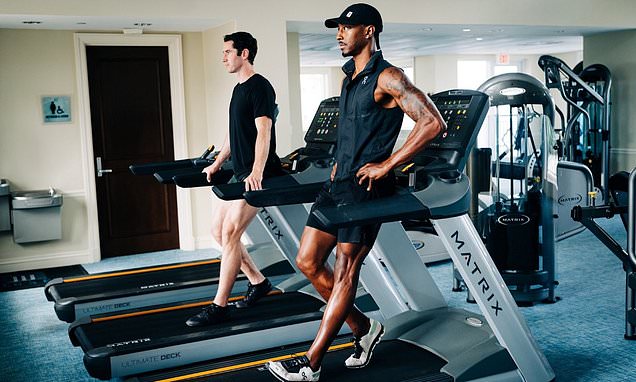Trying to lose weight? Walk BACKWARDS on a treadmill: Fitness expert says bizarre fitness trick can help you burn more fat
- Jumping on the treadmill may sound like the obvious solution to lose weight
- But instead of using it normally, try spinning around and walk backwards
- One fitness researcher says the bizarre trick brings ‘increased health benefits’
Desperately trying to lose weight? Jumping on the treadmill might sound like the obvious solution.
But instead of using it normally, try spinning around and walk backwards.
One fitness researcher says the bizarre trick — which he admits is tricky — brings ‘increased health benefits’.
Jack McNamara, a lecturer in clinical exercise physiology at the University of East London, claims it may help you beat the bulge.

One fitness researcher says walking backwards brings ‘increased health benefits’
Eating your greens, scrapping takeaways and hitting the gym are the obvious go-to options in the quest to lose weight. But for anyone struggling to ditch a dress size, experts claim that there’s a plethora of quirky hacks that could be of assistance.
He pointed to one study, which found women who followed the strange exercise regime for six weeks lost more weight than peers who exercised as normal.
The research, published in 2005, recruited 26 women. Half followed a six-week backward walking training programme and lost 2.4 per cent of their body weight.
Mr McNamara said the activity burns 40 per cent more energy than walking forwards at the same speed.
This is because it requires more concentration and uses extra muscles.
One of the other major benefits of walking backwards, according to Mr McNamara, relates to improving stability and balance.
It causes us to take shorter, more frequent steps.
This, experts claim, leads to ‘improved muscular endurance for the muscles of the lower legs while reducing the burden on our joints’.
The activity also forces a shift in posture and uses muscles that support the lumbar spine — the five vertebrae in the lower back. Strengthening these can lower the risk of back pain.
Writing in The Conversation, Mr McNamara said: ‘Walking backwards is simple, but that doesn’t mean it’s easy.
‘So, how can you add walking backwards into your exercise regimen?
‘When walking backwards, we’re more likely to miss obstacles and hazards that we could crash into or fall over.
‘So in the interest of safety, it’s best to start indoors where you won’t crash into someone or outside in a flat, open area.
‘Once you become more confident walking backwards, you can begin to speed things up and even transition to a treadmill, being sure to use the guide rails when necessary.’
People who don’t want to run backwards can still make walking more difficult — by dragging weights along with them.
Mr McNamara said: ‘If using weights, start light.
‘Focus on multiple sets rather than prolonged distances, and maintain the integrity of your technique over no more than a 20-metre distance to begin with.’
The NHS says people should do two-and-a-half hours of moderate-intensity physical exercise per week.
This can include brisk walking, cycling and pushing a lawn mower.
Adults should also do muscle-strengthening activities, like carrying heavy shopping bags, lifting weights and heavy gardening, at least two days a week.
HOW MUCH EXERCISE YOU NEED
To stay healthy, adults aged 19 to 64 should try to be active daily and should do:
- at least 150 minutes of moderate aerobic activity such as cycling or brisk walking every week and
- strength exercises on 2 or more days a week that work all the major muscles (legs, hips, back, abdomen, chest, shoulders and arms)
Or:
- 75 minutes of vigorous aerobic activity such as running or a game of singles tennis every week and
- strength exercises on 2 or more days a week that work all the major muscles (legs, hips, back, abdomen, chest, shoulders and arms)
Or:
- a mix of moderate and vigorous aerobic activity every week – for example, 2 x 30-minute runs plus 30 minutes of brisk walking equates to 150 minutes of moderate aerobic activity and
- strength exercises on 2 or more days a week that work all the major muscles (legs, hips, back, abdomen, chest, shoulders and arms)
A good rule is that 1 minute of vigorous activity provides the same health benefits as 2 minutes of moderate activity.
One way to do your recommended 150 minutes of weekly physical activity is to do 30 minutes on 5 days every week.
All adults should also break up long periods of sitting with light activity.
Source: NHS
Source: Read Full Article
